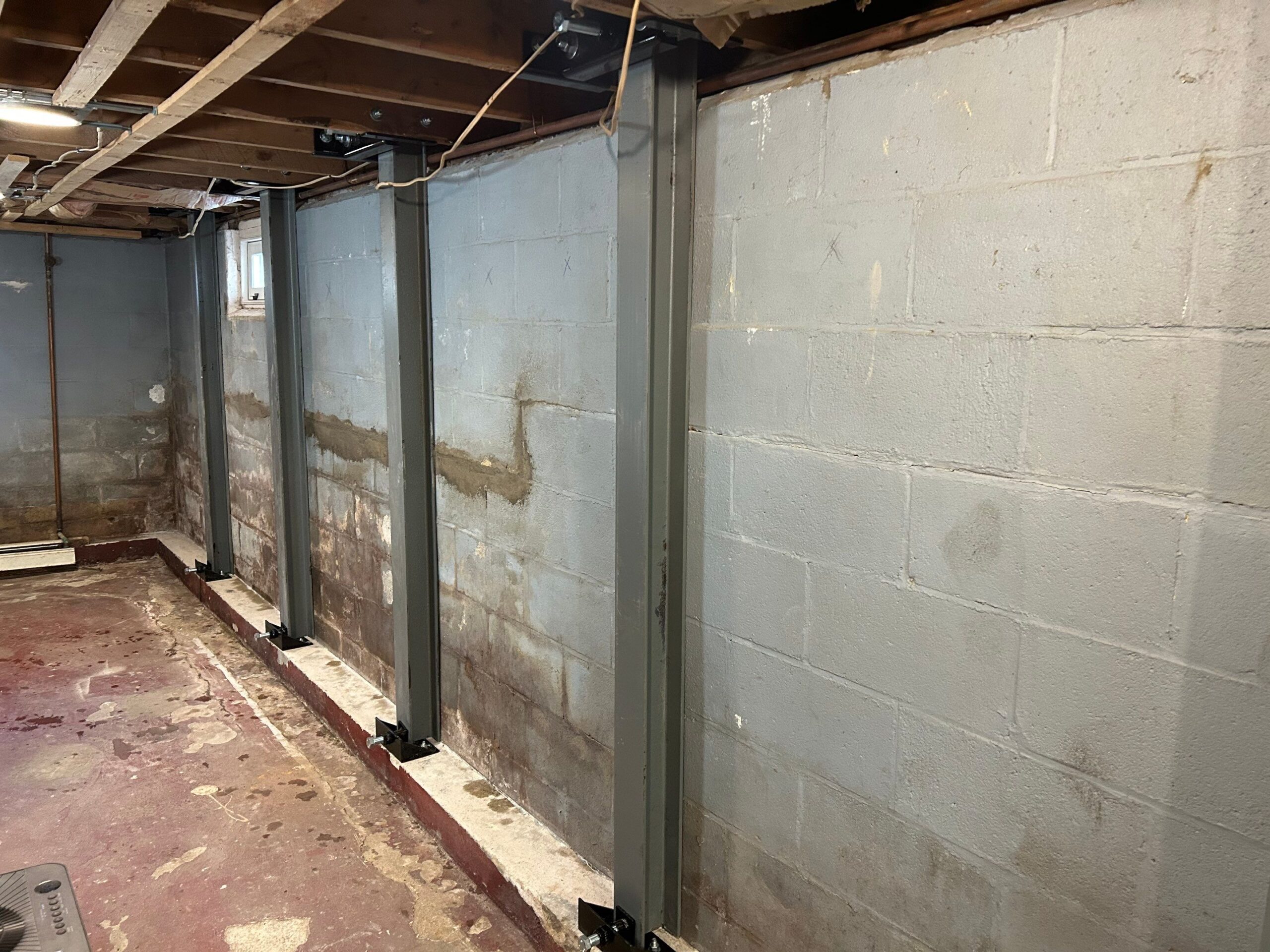Your foundations are one of the most important, yet all too often most neglected parts of your home. They provide the stability that keeps everything else standing, so if there’s any warning sign that damage might be occurring, it’s worth investigating. Perhaps the scariest looking (though not always the largest cause for concern) is the appearance of cracks in the walls and floors. Cracks come in all shapes and sizes. If they’re small and vertical, it’s most likely caused by your home settling (though it could be a symptom of something more serious). If you’re noticing horizontal foundation cracks running around your basement walls, that is a bit more alarming.
What Causes Horizontal Foundation Cracks?
Concrete is pretty sturdy stuff and can take a lot of pressure, which makes it ideal material for the construction of foundation walls. That being said it’s not impervious to damage. It can and will start to crack under certain conditions.
Horizontal foundation cracks are generally caused by one (or a combination) of four things:
Hydrostatic Pressure
All soil naturally contains moisture, but its levels fluctuate due to factors like heavy rainfall or poor drainage. This moisture exerts hydrostatic pressure against your foundation walls. While your home was likely designed to withstand typical pressure levels, excessive moisture can push beyond its limits. Over time, this pressure can lead to cracks, displaced blocks, and even bowing walls. Once structural movement begins, the problem will only escalate if left unaddressed.
Frost Heave and Soil Expansion
Another major issue caused by moisture in the soil around your home is frost heave and soil expansion. When water freezes, it expands—a fact anyone who’s left a drink in the freezer for too long knows all too well. This expansion increases pressure on your foundation, potentially leading to cracks. Once a crack forms, the freeze-thaw cycle accelerates the damage. Water seeps in, freezes, expands, and gradually forces the crack wider. Over just a few years, what starts as a small fissure can grow into a serious structural problem.
Structural Issues and Poor Construction
As we said above, your home is likely built to withstand typical pressure conditions. Unfortunately, ‘likely’ is a far cry from ‘definitely’ and there are a surprising number of poorly constructed buildings out there. One common weakness in many homes—sometimes with serious consequences—is inadequate foundation reinforcement.
Even if your home was built well, nothing lasts forever and the wear and tear of years will take its toll. As concrete ages it slowly starts to lose some of its structural stability, especially if it’s not been properly waterproofed. Eventually, this could lead to horizontal foundation cracks forming.
Vehicles or Heavy Equipment Loads
A final potential cause of horizontal basement wall cracks comes from outside the home entirely. Too much weight placed near the walls can cause stress cracks to form as the soil is pushed downwards and outwards under the load.
Why Are Horizontal Foundation Cracks More Serious Than Vertical Cracks?
As a general rule, horizontal cracks in walls are more likely to be serious than vertical ones. While neither are things that you want to see spreading along your basement walls, vertical cracks are much more likely to be caused by the normal process of settling. This is caused by the weight of your property shifting slightly and can be easily repaired if necessary and in many cases can be safely ignored.
Horizontal foundation cracks, however, indicate more worrying structural movement or extreme external pressure. If left unrectified, this will almost certainly get worse.
Signs of Worsening Damage
Signs that your horizontal basement cracks are a symptom of a more serious problem include things like:
- Bowing or bulging walls
- Water seepage
- Increased moisture levels in your basement
- Cracks widening or spreading over time
Any of these signs is a serious warning. Ignoring them can lead to really serious damage, foundation instability or, in extreme circumstances, the whole building failing.
How to Inspect and Identify Horizontal Basement Cracks
It’s not always easy to spot a horizontal foundation crack. Finished basements, shelves or just piles of old stuff can obscure your view. That means that taking a methodical approach to inspections is your best chance.
Where possible, cast a careful eye over your interior and exterior walls, looking out for cracks, dampness, mold or water stains. These last three are particularly useful warning signs if you’ve got a finished basement and can’t see the walls themselves.
If you do find a crack, measure its width and take note. Come back every week or two and measure it again; if it’s growing wider, you’re facing an on-going problem and need to act.
When To Call A Professional
Cracks that are less than 1/8th of an inch wide, don’t seem to be growing and remain dry probably don’t need an urgent investigation. If any of those things change, call a professional to identify the causes and develop a solution.
If there’s more serious signs of damage like water intrusion or bowing walls, that is much more urgent. These are signs of a problem that has progressed to the next level and will require work to be done relatively quickly.
As a general rule, the faster you act, the less work will be needed and the cheaper the project will be. These really aren’t problems you want to ignore for many, many reasons.
Repair Options
The process for repairing horizontal foundation cracks can vary from the quick and simple to extensive structural repairs. Which solution is right for your situation will depend on a number of factors, but usually, the quicker you act, the less work will be needed.
Epoxy Injection
For minor horizontal cracks, structural epoxy injections can be used to bond the concrete and restore its strength. Unlike polyurethane, which is primarily for waterproofing, epoxy creates a rigid repair that helps prevent further movement. However, this method is only suitable for small, stable cracks. If the damage is more severe, additional repairs will be necessary.
Carbon Fiber Reinforcement
Reinforcing your walls with carbon fiber is the next step up. This method prevents further movement and can be applied to remedy moderate cracks or even bowing walls. Carbon fiber is bonded to the walls, allowing you to add its tensile strength to your reinforcement efforts.
This is a great solution if the cracks or bowing is caught relatively early.
Wall Anchors or Bracing

If the damage has progressed beyond what carbon fiber reinforcement can handle, more substantial solutions are needed. The two primary options are bracing and wall anchors.
Bracing involves installing steel I-beams vertically along the affected wall to prevent further movement. These beams are secured at the floor and ceiling, providing stabilization without requiring excavation, making this a non-invasive option.
Wall anchors, on the other hand, require more extensive work. This method involves inserting a metal rod through the wall and connecting it to a large anchor plate buried in stable soil outside. By tightening the rod, the anchor gradually pulls the wall back into position, using the weight of the surrounding soil for support.
While wall anchors require excavation, both solutions are highly effective at stabilizing and preventing further structural damage. In severe cases, they may be the best way to avoid total foundation failure.
Preventing Future Horizontal Foundation Cracks
Prevention is always better than a cure, especially when it comes to the stability of your home. Luckily, preventing foundation cracks from forming in the first place needn’t be a particularly complex task.
There are three things that you can do fairly easily:
Improve Drainage Around Your Home
The simplest task that any homeowner should do to keep their basement safe from horizontal foundation cracks is keep their gutters in good order. These direct the rainwater that hits your roof away from your foundation. Keeping them and their attached downspouts clear and well maintained can help avoid issues developing in the first place.
It’s also worth considering improving your home’s grading and extending the length of any underground downspouts. These steps will both help to ensure that any water is carried safely away.
Reduce Soil Pressure
Reducing the pressure on your basement walls can be as simple as giving a little thought to your gardening. Avoid planting trees close to the walls of your building, especially ones with invasive roots. Native shrubs are great for absorbing water and pose a lot less risk.
For a more involved approach, installing French drains will allow the water that causes problems with hydrostatic pressure an easier route to drain through. Along with an internal sump pump this system will help reduce problems with rising groundwater.
Routine Inspections
The single most important thing that any homeowner can do is keep an eye on their property. Water related problems will only get worse if ignored, so catching them quickly can save you significant stress and financial pressure.
It’s well worth scheduling an annual inspection from the professionals to help catch things as they start to develop. This goes double for homes in high-risk areas.

